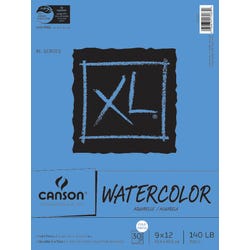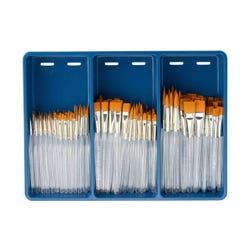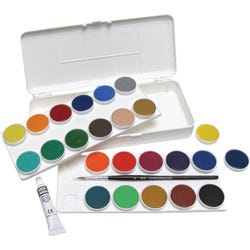Watercolor Landscapes

Description
Lesson Plan and Artwork by Joe Culotta
In this lesson, students will be introduced to the idea of developing a landscape painting using heavyweight 140-lb. paper which has a cold press texture for a variety of watercolor techniques.
Objectives
- Students will create watercolor paintings utilizing Art Elements of line, color, form, shape, and texture.
- corporate into their paintings. Through practice, the art of watercolor painting will allow students to study and paint flowers, birds, and landscapes.
- Students should also be encouraged to study the Watercolor Masters such as Sargent, Rodin, Turner, and Pissarro.
Supplies Needed
Supply #1 401177 Talens® Transparent Watercolor Paint Set with 5 ml Tube of White, Set of 24 (Kit includes 12 sets)
Supply #2 401175 Talens® Opaque Watercolor Paint Set with 5 ml Tube of White, Set of 24 (Kit includes 12 sets)
Supply #3 1371707 Canson® XL® Heavy Weight Watercolor Pad, 140 lb, 9" x 12", 30 Sheets
Supply #4 402318 Royal Brush® Golden Taklon Paint Brush Combo Pack, Assorted Sizes, Pack of 144
*Here are the supplies needed for this lesson plan for reference. Find a convenient carousel of shoppable products for this lesson below.
Standards
CONTENT Standard #1: Generate and conceptualize artistic ideas and work.
CONTENT Standard #2: Organize and develop artistic ideas and work.
CONTENT Standard #3: Define and complete artistic work.
CONTENT Standard #4: Select, analyze and interpret artistic work for presentation.
CONTENT Standard #5: Develop and refine artistic work for presentation.
CONTENT Standard #6: Convey meaning through the presentation of artistic work.
Instructions
1
Students will collect photographs of landscapes from each season of the year. Encourage students to bring in photographs they have taken of scenes either in their locale or from vacation trips. Students will discuss the subject matter they have chosen and define the season and color palette they will use to execute the watercolor. Selecting proper tools and materials for watercolors has a profound effect on the results you get.
2
Once the students have covered the basics of supplies and materials, they will practice a wide variety of painting techniques such as dry brush, graded washes, flat washes, scrafito, masking techniques, and various applications such as salt, alcohol, additives for interesting textures.
Have the students divide a piece of the watercolor paper into seven areas with making tape. Each area will then be used to practice the various techniques in watercolor painting.
3
Using the techniques learned in the practice piece, the students will incorporate these along with the critical components necessary to pull together a successful work of art. Factors to consider include subject, center of interest, shapes, lines, movement, values, color harmony and contrast, and many other elements that work together to create a successful composition.
4
Assessments: Students will discuss their own landscape paintings and how each art element was utilized. They will emphasize the source of their subject matter. Was this a photo taken on a trip or vacation or a locale near their home. They should also discuss how they used line, color, form, and shape in the composition that emphasizes the season, time of day, and their chosen focal point in the work.






